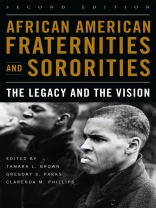The first African American fraternities and sororities were established at the turn of the twentieth century to encourage leadership, racial pride, and academic excellence among black college students confronting the legacy of slavery and the indignities of Jim Crow segregation. With a strong presence that endures on today’s campuses, African American fraternities and sororities claim legendary artists, politicians, theologians, inventors, intellectuals, educators, civil rights leaders, and athletes in their ranks. In this second edition of African American Fraternities and Sororities: The Legacy and the Vision, editors Tamara L. Brown, Gregory S. Parks, and Clarenda M. Phillips have added new chapters that address issues such as the role of Christian values in black Greek-letter organizations and the persistence of hazing. Offering an overview of the historical, cultural, political, and social circumstances that have shaped these groups, African American Fraternities and Sororities explores the profound contributions that black Greek-letter organizations and their members have made to America. New in the second edition: • Examination of the relationship between Christian values and organizational identity • Investigation of hazing rituals • Survey of academic performance in black Greek-letter organizations • Discourse on notions of masculinity in black Greek-letter organizations • Accounts of the professional lives of black Greek luminaries
Innehållsförteckning
Pledged to Remember: Africa in the Life and Lore of Black Greek-Letter Organizations
The Origin and Evolution of College Fraternities and Sororities
Faith and Fraternalism: A History
Black Fraternal and Benevolent Societies in Nineteenth-Century America
The Grand Boulé at the Dawn of a New Century: Sigma Pi Phi Fraternity
Education, Racial Uplift, and the Rise of the Greek-Letter Tradition: The African American Quest for Status in the Early Twentieth Century
In The Beginning: The Early History of the Divine Nine
Lobbying Congress for Civil Rights: The American Council on Human Rights, 1948-1963
Academic Achievement of African American Fraternities and Sororities
Lucy Diggs Slowe: Not a Matron but an Administrator
A Social History of Everyday Practice: Sadie T. M. Alexander and the Incorporation of Black Women into the American Legal Profession, 1935-1960
Sister Acts: Resistance in Sweetheart and Little Sister Programs
The Body Art of Brotherhood
Calls: An Inquiry into Their Origin, Meaning, and Function
Variegated Roots: The Foundations of Stepping
What a Man: The Relationship between Black Fraternity Stereotypes and Black Sorority Mate Selection
Racism, Sexism, and Aggression: A Study of Black and White Fraternities
The Empty Space of African American Sorority Representation: Spike Lee’s School Daze
Bloody, but Unbowed: Making Meaning of Invictus and If— for the Shaping of a Collective Black Greek Identity
The Continuing Presence of Hazing during the Fraternity Membership intake Process Post 1990
Om författaren
Clarenda M. Phillips is chair of sociology, social work, and criminology at Morehead State University.












